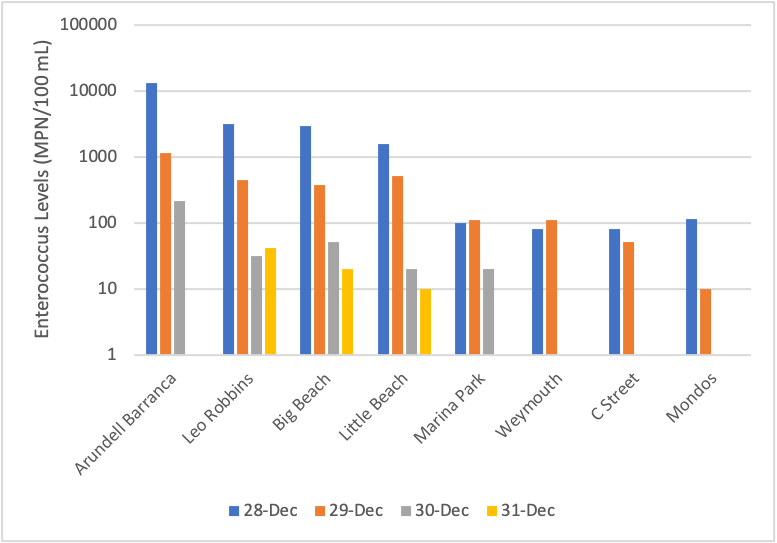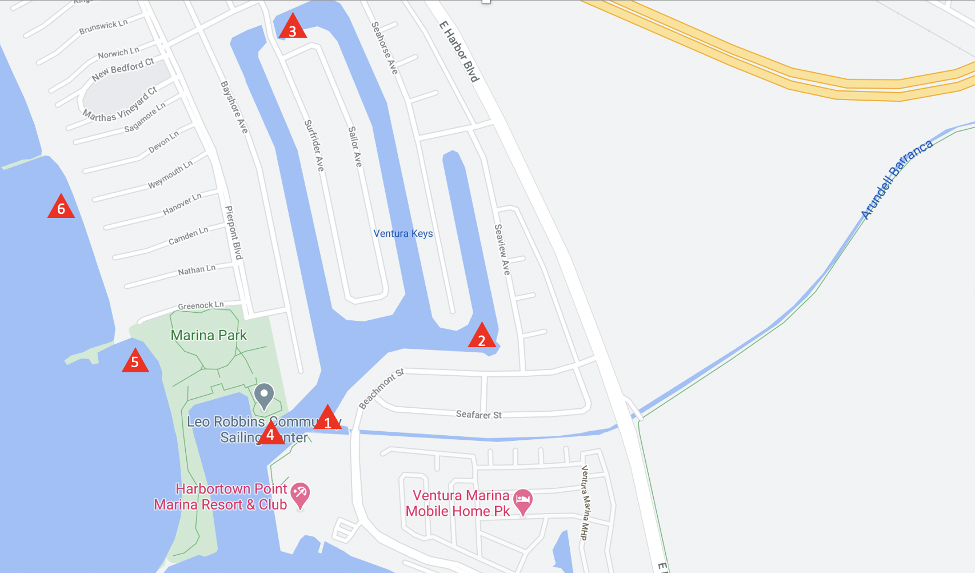
The Surfrider Foundation Ventura County Chapter’s Blue Water Task Force (BWTF) collected and tested samples for enterococcus levels at, and near, the Arundell Barranca and select Ventura County beaches during and after the first significant rain event (> 1 inch rainfall) of the season (2020-2021). The Arundell Barranca is a major channel that starts at the Ventura Foothills, flows through Ventura, and discharges into the Ventura Harbor. For more information on the Arundell Barranca see the venturariver.org blog post Ventura River Ecosystem.
Samples were collected where the Arundell Barranca discharges into the Ventura Harbor, and at 5 sites near the Arundell Barranca (see Figure 1) to assess the impact (as measured by enterococcus levels) of the rain event. Sites 2 and 3, Big Beach and Little Beach, respectively, are located within the Ventura Keys neighborhood. Leo Robbins (site 4) is a local sailing center, Marina Park (site 5) and the end of Weymouth (site 6) are beaches in the Pierpont neighborhood. In addition, ocean water samples were collected from C Street and Mondos (not pictured below) to assess the impact of the first major rain event on these locations.
Figure 1. Sites tested near the Arundell Barranca

1 = Arundell Barranca discharge site; 2 = Big Beach (Ventura Keys); 3 = Little Beach (Ventura Keys); 4 = Leo Robbins; 5 = Marina Park; 6 = End of Weymouth
This rain event began on the evening of 12/27/20 and lasted through the afternoon of 12/28/20. The total rainfall was estimated at 1.04 inches (https://www.vcwatershed.net/fws/gmap.html). Note there was one previous rain event in the season that occurred in November which was estimated at 0.53 inches.
The first samples were taken on 12/28/20 during the rain event and for 3 days after the rain stopped (12/29/20, 12/30/20, and 12/31/20). Samples were collected between 8 am and noon on each day. Enterococcus levels were measured using the U.S. EPA-approved IDEXX Colilert Test. Results are shown in Table 1 and Figure 2 below.
Table 1. Enterococcus levels (MPN/100 mL) after first major rain event

Figure 2. Enteroccus levels after the first major rain event:

Enterococcus levels were highest on the day of the rain event, 12/28/20, for all sites tested with the exception of Marina Park and Weymouth which increased slightly on 12/29/20 compared to 12/28/20. With the exception of Weymouth and Marina Park, enterococcus levels decreased in a time-dependent fashion through 12/31/21. Based on the state standard of <104 MPN/100 mL, sites 1 through 6 (at and near the Arundell Barranca) failed to meet the state standard on the day of the rain event and the day after. The Arundell Barranca tested at ~13,000 MPN/100 mL on the day of the rain event, and the sites immediately surrounding the Arundell Barranca (sites 2 through 4) ranged between 1,500 and 3,100 MPN/100 mL on the day of the rain event. Mondos did not meet the state standard on the day of the rain event, however, levels of enterococcus came down within 24 hours. C Street saw increased levels of enterococcus on the day of the rain event but did not exceed the state standard at any time.
In summary, high levels of enterococcus were present at the Arundell Barranca where it discharges into the Ventura Harbor during and immediately following this rain event. Additionally, sites located near the Arundell Barranca were similarly impacted. All sites tested, with the exception of the Arundell Barranca, were below the state standard of 104 MPN/100 mL by 12/30 (~48 hours after the rain had stopped).
About Enterococcus:
Enterococcus bacteria are bacteria that indicate fecal pollution (human or animal waste) and other pathogens that are also found in fecal matter that can make people sick with the stomach flu, rashes, eye and ear infections or worse. The higher the level of the fecal-indicating bacteria enterococcus, the higher the risk of other illness-causing pathogens being present in the water as well. Learn more about the health risks from swimming in water tainted with human sewage or animal waste here.
While not harmful on their own account, enterococcus are a type of fecal bacteria that can indicate the presence of more dangerous microorganisms and viruses. Fecal bacteria are found primarily in the intestinal tracts of mammals and birds, and are released into the environment through human and animal feces. Fecal pollution at beaches could come from pets and wildlife, stormwater runoff, and human sources of sewage. Read more about indicator bacteria and how to identify sources in this Beachapedia article about bacterial pollution.
About BWTF
The Blue Water Task Force is an all-volunteer program that provides critical water quality information to protect public health at the beach. Our labs measure fecal indicator bacteria levels in recreational waters and compare those results to local water quality standards.
Blue Water Task Force labs fill in the gaps and extend the coverage of agency-run beach monitoring programs by sampling ocean beaches, bay beaches, and potential freshwater sources of pollution such as stormwater outlets, rivers and creeks that discharge onto the beach. The Blue Water Task Force operates year-round, even through the off-season when, in many communities, lifeguards leave the beach and health officials stop collecting water samples.
BWTF volunteers on this project included: April Bender, Lynda Blue, Joy Downing Riley, Scott McCarty, Cassie Rogers, Shannon Shoup, and Anna Spiller.автокредит какие ставки
